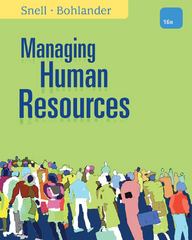Joining Gratterpalm as HR manager five years ago was a challenging proposition both for the company and
Question:
Joining Gratterpalm as HR manager five years ago was a challenging proposition— both for the company and for myself. An award-winning independent retail marketing agency based in Leeds, Gratterpalm creates advertising, point of sale, and design for major clients including the United Kingdom grocery giant ASDA and the sofa retailer DFS.
When I joined the agency in January 2003, Gratterpalm had no HR function whatsoever. Originally a family-run business, it had grown, over twenty-five years, to a team of seventy and had just undergone a management buyout.
The key to introducing HR to Gratterpalm was to introduce a performance review tool that allowed us to benchmark the success of a people-centered culture and allowed every employee the opportunity to have their say. We therefore launched ‘‘Gratter chatter,’’ an employee survey that has become the bedrock of the agency’s HR function. The initial survey highlighted several issues within the agency that clearly needed to be addressed:
■ Team structures were unclear; people did not know who their line manager was and reporting lines were blurred in some departments.
■ Work/life balance was poor.
■ There was a lack of understanding of company values.
■ Only 66 percent stated they enjoyed working at Gratterpalm.
■ There was a low commitment to training and development.
■ Employees did not believe the survey was confidential or anonymous, so there was an initial lack of trust and only 70 percent completion.
Many initiatives have been taken to address the issues thrown up by the first and subsequent surveys. These include:
■ Clearly defined role profiles, so everyone understands their role.
■ Biannual people asset reviews to ensure that we are aware of all employee development needs and are able to take relevant action.
■ To help address the work/life balance we introduced a ‘‘justification to recruit’’ procedure to ensure that there was a rigorous thought process before recruitment took place.
■ An increase in flexible working opportunities—10 percent of employees now enjoy flexible working.
■ The introduction of child care vouchers as a part of our range of benefits.
■ Management huddles that take place on a weekly basis as a valuable communication tool—we also have an annual company meeting focusing on our three-year business plan and there is regular communication and reminders of our values.
■ Introduction of an in-house training schedule that is rolled out twice a year and the establishment of a course evaluation process.
■ Exit interviews that take place for all leavers.
Another important development has been the introduction of a structured appraisal procedure, ‘‘Let’s Talk,’’ which ensures that employees are given feedback on their performance and set objectives for the forthcoming year. We also put into place a clear career structure so that employees were aware of how they could progress to the next level. An internal vacancies notice board and procedure were introduced, and as a result of these initiatives 10 percent of employees were promoted internally last year. Some of the company’s stars today are those who were, in the past, not thought to be strong performers, but they have managed to turn their careers around with the help of effective people management. Clients have played an active role in the recruitment process.
Some of the challenges for HR have been aligning it to the wider business as Gratterpalm grows and develops in line with its business plan. One of these areas was developing the company’s corporate social responsibility (CSR) credentials. Initiatives include employees reading to children on a weekly basis at our local primary school, and the introduction of plastic, metal, and glass recycling bins into the business to encourage employees to recycle. We are establishing links with two charities, and we are currently planning an ‘‘empty car park’’ day to encourage car sharing, cycling, and the use of public transport.
The key results achieved by HR at Gratterpalm in the five years from 2003 to 2008 are highlighted as follows:
■ Employee turnover reduced from 30 percent to 15 percent.
■ Attendance rates increased from 90 percent to 98 percent through successful attendance management including welcome back meetings after all absences.
■ Gratter chatter (the employee survey) response rates increased from 70 percent to 100 percent.
■ Those that believe Gratterpalm is a ‘‘very good place to work’’ reached its highest score of 85 percent this year.
■ Of new recruits taken on in the last 12 months, 60 percent have been through direct means (web or recommended through contacts/employees).
■ Gratterpalm is becoming an employer of choice and our name is becoming more known within the industry.
Questions
1. How are Gratterpalm’s new HR activities driving business growth for the company?
2. Why are “basic” HR functions sometimes difficult for small firms to execute? How can they improve their capacity to successfully implement HR programs?
3. Why does it takes time to see the results of HR activities?
Step by Step Answer:

Managing Human Resources
ISBN: 9781133707394
16th Edition
Authors: James Stewart, Scott A Snell, George Bohlander





